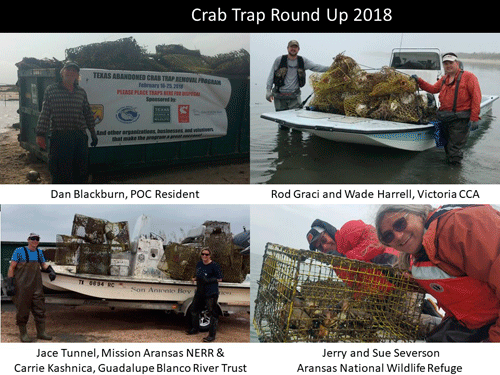
Organized efforts led by three groups have resulted in the collection of over 1000 derelict traps from area bays during the 10-day closure to commercial crabbing. Mandated by Texas Parks and Wildlife Department, the purpose of the closure each February is to allow identification and removal of traps that have been lost or displaced and are not being fished.
The San Antonio Bay Foundation, led by director Dan Alonso, concentrated efforts in the Guadalupe River, Traylor’s Cut, Guadalupe Bay, Mission Lake, Hynes Bay and on the west side of SA Bay from Austwell. Efforts were guided by aerial survey at the beginning of the closure period. Participating organizations included Mission Aransas National Estuary Research Reserve, Texas Water Development Board, The Nature Conservancy, Colville Ranch, Swan Lake Ranch, Dow Chemical volunteers, USAA volunteers, Guadalupe Blanco River Authority and River Trust, and several non-affiliated individuals.
The San Antonio Bay Partnership, led by Chair Allan Berger, focused its efforts on the Port O’ Connor area, both Matagorda Bay and Espiritu Santo Bay, and into San Antonio Bay to Panther Point and the Victoria Barge Canal from Charlie’s Bait Camp. Boats and crews from CCA chapters in Port O’Connor, Victoria and San Antonio were represented, as were members of the Mid-Coast Texas Master Naturalists and the Coastal Bend Paddling Club.
The Aransas National Wildlife Refuge had crews collecting traps from Panther Point in San Antonio Bay to the west through Mesquite, Carlos, Dunham, Sundown, and St. Charles Bays and along the Refuge shorelines, according to Refuge Biologist Andrew Stetter.
Additionally, other interested individuals picked up traps and brought them to the collection points.
According to Norman Boyd, San Antonio Bay Ecosystem Leader for TPWD, an estimated total of 987 traps from the San Antonio Bay system and 54 traps from Matagorda Bay were collected in his bins over the 10-day closure period. That compares with 575 collected in 2017. While Hurricane Harvey resulted in more displaced traps, the success of the program was driven by an organized approach by 20 boats and 49 volunteers over the closure period. Boyd also believes, that once the results are finalized, the San Antonio Bay system will have collected more traps that the rest of the State combined – a testament to the efforts of the three organizations leading the efforts.
Boyd states that the removal of these traps is important to maintain the health of the bays, both ecologically and aesthetically. The derelict traps that are in the water continue to fish, attracting crabs and fish that then die and attract more crabs and fish – an ongoing killing cycle. These traps are also hazard to boats and propellers. The traps on the ongoing killing cycle. These traps are also a hazard to boats and propellers. The traps on the shore are unsightly trash.
The bays are now open again to crab fishing until February 2019 when volunteer efforts will again be needed to assist in picking up derelict traps. If you missed this years’ efforts but want to be included next year, contact Allan Berger at allanrberger@comcast.net or Dan Alonso at dalonso@sabay.org to get a reminder. They are confident you will find the effort interesting, rewarding, and fun.
